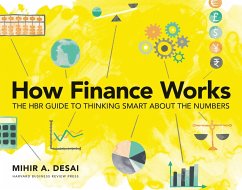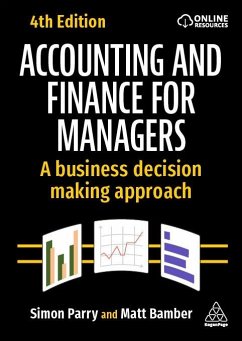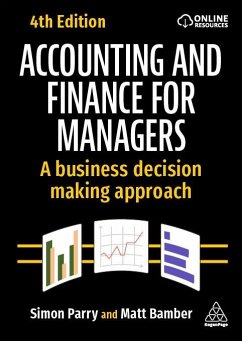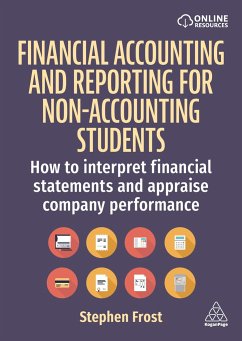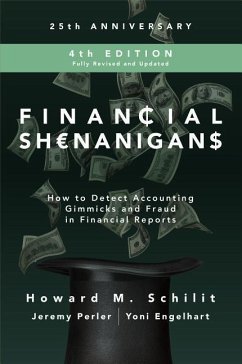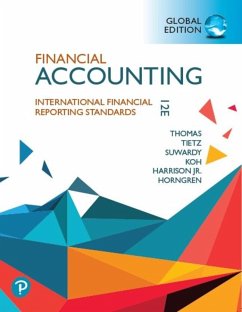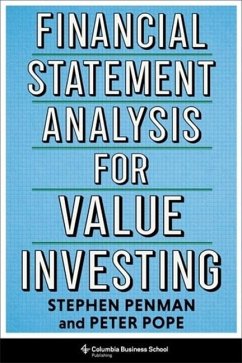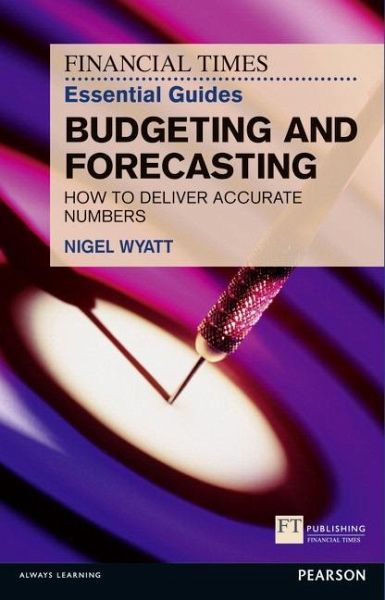
Financial Times Essential Guide to Budgeting and Forecasting, The
Versandkostenfrei!
Versandfertig in 1-2 Wochen
14,99 €
inkl. MwSt.
Weitere Ausgaben:

PAYBACK Punkte
7 °P sammeln!
Gain the knowledge and confidence you need to build and manage budgets and forecast financial information.
This book demystifies budgets and forecasts, providing simple explanations and clear examples. It includes integrated checklists, goals and milestones, to ensure you are on target to achieve the best results.
Part of The Financial Times Essential Guides series: Task-focused and results-orientated, the essential guides are for every manager who wants to move their skills beyond the ordinary to the best.
Product Description
Gain the knowledge and confidence you need to build and manage budgets and forecast financial information.
This book demystifies budgets and forecasts, providing simple explanations and clear examples. It includes integrated checklists, goals and milestones, to ensure you are on target to achieve the best results.
Part of The Financial Times Essential Guides series: Task-focused and results-orientated, the essential guides are for every manager who wants to move their skills beyond the ordinary to the best.
Backcover
This is a practical book from which managers at all levels will benefit and learn how to avoid the pitfalls of budgeting and forecasting. A must read book.
Manjit Biant, management consultant
Love them or hate them budgets are part of the corporate landscape. Nigel Wyatt's book makes a strong case that budgeting can still prove an invaluable tool for focusing strategic thinking and managing your business. The book gives some great tips and advice on how to use them and get the best from them.
Paul Lower FCMA FInstLM, former FD and business coach
This book is an excellent tool for those responsible for preparing budgets and forecasts. It will encourage the reader to take actions which will benefit their own organisation.
Juan Carlos Venegas ICPA CFC ICFS IPFM, accountant, forensic consultant, counter fraud specialist and fraud examiner
The task-focused, results-oriented guide to delivering numbers that add up.
The Financial Times Essential Guide to Budgeting and Forecasting will help you:
Understand finance and budgeting terms
Communicate more coherently and comprehensively with financially astute colleagues and stakeholders
Better understand the health of your business or business unit
Take a more proactive role in helping your business achieve its goals
Reflect on, evaluate and learn from your experience
With advice thats instantly applicable, whether youre taking responsibility for a budget for the first time or youd like to know more about how finance works, this is the one guide you cant do without.
Contents
About the author
Acknowledgements
Introduction
Part 1 Preparing your budgets
1 What is the budget for?
Introduction
The role of budgets why do we have them?
1 Meeting the organisations objectives
2 Planning
3 Monitoring and controlling
4 Co-ordinating
5 Evaluating performance
6 Improving performance
7 Motivating managers
8 Management contract
9 Communicating
10 Providing a basis for authorising expenditure and delegating responsibility
11 Identifying scarce resources
12 Allocating resources
13 Demonstrating and delivering good corporate governance
Linking budgets to strategy and policy
Budgets for special purposes
Planning periods
2 What is a forecast and how does it differ from a budget?
What is the difference between a budget and a forecast?
Benefits of forecasting beyond the wall
Forecasts, projects and contracts
Forecasting tools and techniques
Sales forecasting
Quantitative forecasting using Microsoft Excel
Useful Excel tools
Forecast frequency and automation
Measuring and improving forecast accuracy
Forecast financial statements
New product sales forecasting
Other factors to consider in sales forecasts
3 Essential background financial skills for budgeting
Cheaper is not always better: cost and value in budgeting
Accruals, cash and commitment accounting and budgeting
Understanding profit and loss account figures
Review of accruals accounting
Direct and indirect methods of producing cash flow accounting
The balance sheet
The master budget
Costs
Value analysis and value engineering
Activity based costing (ABC)
The breakeven model
Cost structure
Capital expenditure planning
4 How should the budget be built?
Introduction
Building budgets
Incremental budgeting
Zero based budgeting
Activity based budgeting
Should budgets be top-down or bottom-up?
Fixed v flexible budgets
External comparison driven budgets
VFM, outcome orientated and evidence based budgets
The power of evidence in protecting budgets
Good budgeting practice and ideas for constructing a budget
Setting budgets for contingencies
The challenge process
Building budgets and performance measurement
The budget game
Presenting budgets
5 How should cash be budgeted and controlled?
Planning systems and cash flow forecasting
Managing working capital cash and risk
Managing trade debtors (accounts receivable)
Managing stock (inventory)
Managing trade creditors (accounts payable)
Cash flow in a business
6 How should capital expenditure be budgeted for?
What is capital expenditure?
The payback rule
NPV and DCF
Capital rationing: profitability index
Strategic fit and roadmaps
Sensitivity analysis
Risk
Post-investment appraisal
Long-term cash flow planning
Asset replacement and enhancement
Investment in working capital
Part 2 Managing your budget and delivering performance
7 Back to basics: living within your means and delivering VFM
Budget feedback mechanism
Ratios and budgets
Managing budgets
The VFM model for managing and planning budgets
8 Making sense of standard costing and variances
Making sense of variances
Standard costing
Breakdown of variances
Practical variance analysis without standard costing
9 Risks, forecasts, balanced scorecards and KPIs
The balanced scorecard and strategy maps
KPIs and budgets
Values, mission and vision statements and budgets
Risks and budgets
10 Delegating budgets to others
Why delegate?
Devolved or delegated budgets
McGregors theory X and theory Y
The key to successful delegation
11 Beyond budgeting
Introduction
Are budgets bad for business?
Implementing beyond budgeting
Achieving objectives obliquely obliquity
Conclusion
Part 3 Reviewing your budgeting and forecasting performance
12 What lessons have you learned?
Take action and responsibility
Personal action plans
Templates to review your learning and construct an action plan
Beyond action plans: how do you know you have been successful?
Index
This book demystifies budgets and forecasts, providing simple explanations and clear examples. It includes integrated checklists, goals and milestones, to ensure you are on target to achieve the best results.
Part of The Financial Times Essential Guides series: Task-focused and results-orientated, the essential guides are for every manager who wants to move their skills beyond the ordinary to the best.
Product Description
Gain the knowledge and confidence you need to build and manage budgets and forecast financial information.
This book demystifies budgets and forecasts, providing simple explanations and clear examples. It includes integrated checklists, goals and milestones, to ensure you are on target to achieve the best results.
Part of The Financial Times Essential Guides series: Task-focused and results-orientated, the essential guides are for every manager who wants to move their skills beyond the ordinary to the best.
Backcover
This is a practical book from which managers at all levels will benefit and learn how to avoid the pitfalls of budgeting and forecasting. A must read book.
Manjit Biant, management consultant
Love them or hate them budgets are part of the corporate landscape. Nigel Wyatt's book makes a strong case that budgeting can still prove an invaluable tool for focusing strategic thinking and managing your business. The book gives some great tips and advice on how to use them and get the best from them.
Paul Lower FCMA FInstLM, former FD and business coach
This book is an excellent tool for those responsible for preparing budgets and forecasts. It will encourage the reader to take actions which will benefit their own organisation.
Juan Carlos Venegas ICPA CFC ICFS IPFM, accountant, forensic consultant, counter fraud specialist and fraud examiner
The task-focused, results-oriented guide to delivering numbers that add up.
The Financial Times Essential Guide to Budgeting and Forecasting will help you:
Understand finance and budgeting terms
Communicate more coherently and comprehensively with financially astute colleagues and stakeholders
Better understand the health of your business or business unit
Take a more proactive role in helping your business achieve its goals
Reflect on, evaluate and learn from your experience
With advice thats instantly applicable, whether youre taking responsibility for a budget for the first time or youd like to know more about how finance works, this is the one guide you cant do without.
Contents
About the author
Acknowledgements
Introduction
Part 1 Preparing your budgets
1 What is the budget for?
Introduction
The role of budgets why do we have them?
1 Meeting the organisations objectives
2 Planning
3 Monitoring and controlling
4 Co-ordinating
5 Evaluating performance
6 Improving performance
7 Motivating managers
8 Management contract
9 Communicating
10 Providing a basis for authorising expenditure and delegating responsibility
11 Identifying scarce resources
12 Allocating resources
13 Demonstrating and delivering good corporate governance
Linking budgets to strategy and policy
Budgets for special purposes
Planning periods
2 What is a forecast and how does it differ from a budget?
What is the difference between a budget and a forecast?
Benefits of forecasting beyond the wall
Forecasts, projects and contracts
Forecasting tools and techniques
Sales forecasting
Quantitative forecasting using Microsoft Excel
Useful Excel tools
Forecast frequency and automation
Measuring and improving forecast accuracy
Forecast financial statements
New product sales forecasting
Other factors to consider in sales forecasts
3 Essential background financial skills for budgeting
Cheaper is not always better: cost and value in budgeting
Accruals, cash and commitment accounting and budgeting
Understanding profit and loss account figures
Review of accruals accounting
Direct and indirect methods of producing cash flow accounting
The balance sheet
The master budget
Costs
Value analysis and value engineering
Activity based costing (ABC)
The breakeven model
Cost structure
Capital expenditure planning
4 How should the budget be built?
Introduction
Building budgets
Incremental budgeting
Zero based budgeting
Activity based budgeting
Should budgets be top-down or bottom-up?
Fixed v flexible budgets
External comparison driven budgets
VFM, outcome orientated and evidence based budgets
The power of evidence in protecting budgets
Good budgeting practice and ideas for constructing a budget
Setting budgets for contingencies
The challenge process
Building budgets and performance measurement
The budget game
Presenting budgets
5 How should cash be budgeted and controlled?
Planning systems and cash flow forecasting
Managing working capital cash and risk
Managing trade debtors (accounts receivable)
Managing stock (inventory)
Managing trade creditors (accounts payable)
Cash flow in a business
6 How should capital expenditure be budgeted for?
What is capital expenditure?
The payback rule
NPV and DCF
Capital rationing: profitability index
Strategic fit and roadmaps
Sensitivity analysis
Risk
Post-investment appraisal
Long-term cash flow planning
Asset replacement and enhancement
Investment in working capital
Part 2 Managing your budget and delivering performance
7 Back to basics: living within your means and delivering VFM
Budget feedback mechanism
Ratios and budgets
Managing budgets
The VFM model for managing and planning budgets
8 Making sense of standard costing and variances
Making sense of variances
Standard costing
Breakdown of variances
Practical variance analysis without standard costing
9 Risks, forecasts, balanced scorecards and KPIs
The balanced scorecard and strategy maps
KPIs and budgets
Values, mission and vision statements and budgets
Risks and budgets
10 Delegating budgets to others
Why delegate?
Devolved or delegated budgets
McGregors theory X and theory Y
The key to successful delegation
11 Beyond budgeting
Introduction
Are budgets bad for business?
Implementing beyond budgeting
Achieving objectives obliquely obliquity
Conclusion
Part 3 Reviewing your budgeting and forecasting performance
12 What lessons have you learned?
Take action and responsibility
Personal action plans
Templates to review your learning and construct an action plan
Beyond action plans: how do you know you have been successful?
Index
Gain the knowledge and confidence you need to build and manage budgets and forecast financial information.
This book demystifies budgets and forecasts, providing simple explanations and clear examples. It includes integrated checklists, goals and milestones, to ensure you are on target to achieve the best results.
Part of The Financial Times Essential Guides series: Task-focused and results-orientated, the essential guides are for every manager who wants to move their skills beyond the ordinary to the best.
This book demystifies budgets and forecasts, providing simple explanations and clear examples. It includes integrated checklists, goals and milestones, to ensure you are on target to achieve the best results.
Part of The Financial Times Essential Guides series: Task-focused and results-orientated, the essential guides are for every manager who wants to move their skills beyond the ordinary to the best.




